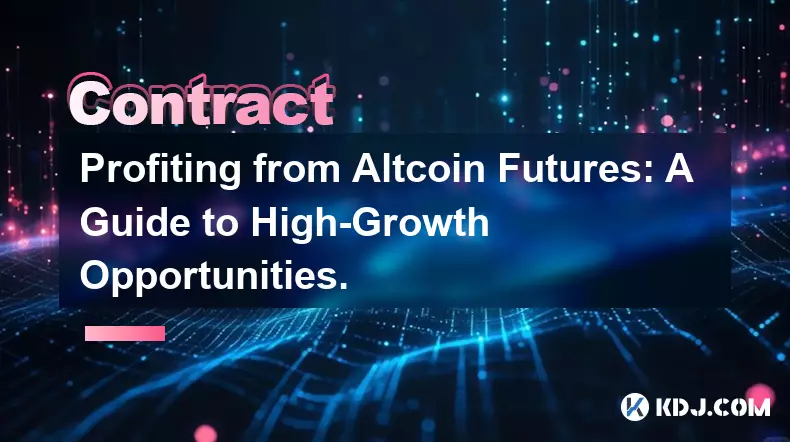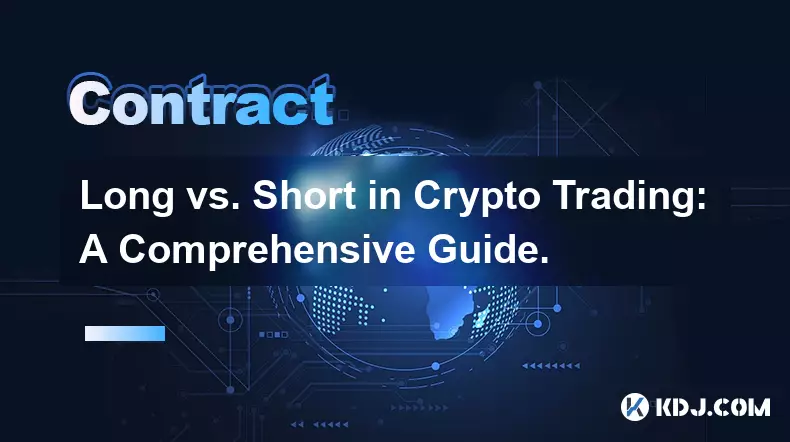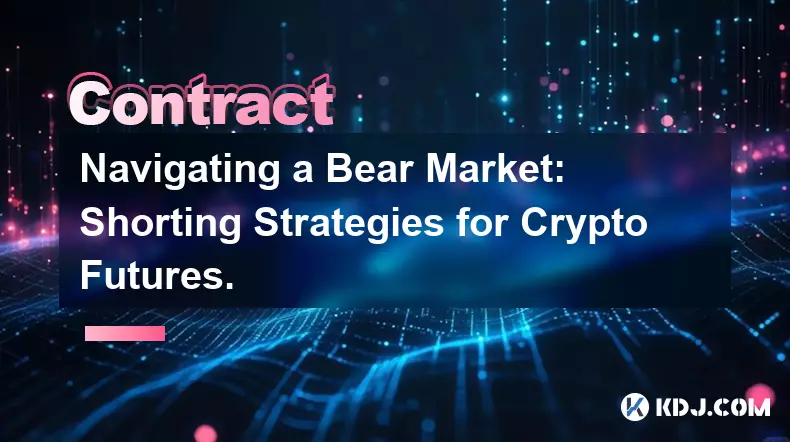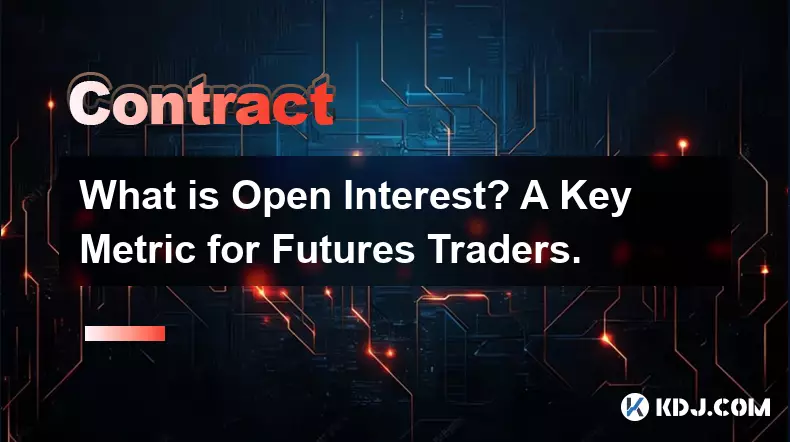-
 bitcoin
bitcoin $107015.826941 USD
-2.18% -
 ethereum
ethereum $3637.352324 USD
-5.18% -
 tether
tether $0.999831 USD
-0.02% -
 xrp
xrp $2.338078 USD
-6.23% -
 bnb
bnb $998.272150 USD
-6.97% -
 solana
solana $167.598257 USD
-10.12% -
 usd-coin
usd-coin $0.999863 USD
0.01% -
 tron
tron $0.282573 USD
-5.09% -
 dogecoin
dogecoin $0.169891 USD
-7.39% -
 cardano
cardano $0.557554 USD
-7.03% -
 hyperliquid
hyperliquid $39.914802 USD
-5.85% -
 chainlink
chainlink $15.414549 USD
-9.97% -
 bitcoin-cash
bitcoin-cash $510.361911 USD
-4.26% -
 ethena-usde
ethena-usde $0.999194 USD
-0.03% -
 stellar
stellar $0.282092 USD
-6.07%
Profiting from Altcoin Futures: A Guide to High-Growth Opportunities.
Altcoin futures offer leveraged exposure to non-Bitcoin cryptocurrencies, enabling traders to profit from price swings without owning the underlying assets.
Nov 03, 2025 at 08:00 pm

Understanding Altcoin Futures and Market Dynamics
1. Altcoin futures are derivative contracts that allow traders to speculate on the future price of non-Bitcoin cryptocurrencies such as Ethereum, Solana, or Avalanche. These instruments enable leveraged exposure, meaning investors can control large positions with relatively small capital outlays. The high volatility typical of altcoins makes them attractive for short-term trading strategies.
2. Unlike spot trading, futures do not require ownership of the underlying asset. Instead, traders agree to buy or sell a specific altcoin at a predetermined price on a set date. This structure allows both long and short positions, opening profit opportunities in rising and falling markets.
3. Market dynamics for altcoin futures are heavily influenced by sentiment, macroeconomic factors, technological upgrades, and exchange listings. Sudden news about network forks, regulatory developments, or whale movements can trigger rapid price swings, creating windows for strategic entries and exits.
4. Liquidity varies significantly across different altcoin futures markets. Major exchanges like Binance, Bybit, and OKX offer deep order books for top-tier altcoins, ensuring tighter spreads and faster execution. Less popular altcoins may suffer from slippage and low volume, increasing risk for active traders.
Risk Management Strategies in Leveraged Trading
1. Leverage amplifies both gains and losses, making risk management essential when trading altcoin futures. Positions with 10x, 20x, or higher leverage can be liquidated quickly during sharp reversals. Traders should define their maximum acceptable loss per trade and adhere strictly to stop-loss orders.
2. Position sizing plays a critical role in preserving capital. Allocating only a small percentage of total funds—such as 1% to 5%—per trade helps withstand drawdowns and avoids catastrophic losses from single adverse moves. Over-leveraging a single position is one of the most common causes of account blowouts.
3. Monitoring funding rates is crucial in perpetual futures markets. Positive funding indicates long dominance, while negative values suggest short pressure. Extremely high funding can signal overleveraged conditions, often preceding corrections. Adjusting exposure based on these indicators improves timing and reduces vulnerability.
4. Diversifying across multiple altcoin futures reduces concentration risk. While Bitcoin and Ethereum dominate volume, smaller-cap altcoins often exhibit stronger momentum during bull phases. A balanced portfolio spread across sectors—DeFi, gaming, infrastructure—can capture asymmetric upside while mitigating sector-specific shocks.
Identifying High-Growth Altcoin Opportunities
1. Fundamental analysis involves evaluating an altcoin’s technology, team, use case, tokenomics, and ecosystem growth. Projects with real-world adoption, active development, and strong community support tend to outperform speculative tokens in sustained rallies. On-chain metrics like daily active addresses and transaction volume provide objective insights into usage trends.
2. Technical analysis complements fundamentals by identifying entry and exit points. Chart patterns, moving averages, RSI divergences, and volume profiles help determine trend strength and potential reversal zones. Combining multi-timeframe analysis increases accuracy, especially when aligning daily trends with intraday setups.
3. Catalyst-driven trading focuses on upcoming events such as mainnet launches, protocol upgrades, exchange listings, or partnership announcements. These moments often precede significant price movements due to increased visibility and speculative interest. Monitoring project roadmaps and social channels helps anticipate key dates.
Traders who combine technical precision with fundamental conviction increase their odds of capturing outsized returns during breakout phases.4. Sentiment analysis tools track social media buzz, search volume, and options positioning to gauge market psychology. Excessive fear can present buying opportunities, while euphoria may warn of overheated conditions. Integrating sentiment data into decision-making adds another layer of context beyond price action alone.
Frequently Asked Questions
What is the difference between altcoin futures and spot trading?Altcoin futures allow traders to bet on future prices using leverage without owning the asset, whereas spot trading involves immediate purchase and ownership of the cryptocurrency at current market value.
How do funding rates affect altcoin futures positions?Funding rates are periodic payments exchanged between long and short traders in perpetual contracts. High positive rates indicate crowded long positions, potentially increasing the risk of liquidation cascades during downturns.
Which exchanges offer the most reliable altcoin futures markets?Binance, Bybit, and OKX lead in terms of liquidity, variety of listed altcoins, and advanced trading tools. These platforms support deep markets for both major and emerging altcoins with competitive fee structures.
Can retail traders compete with institutional players in altcoin futures?Yes, due to the decentralized nature of crypto markets and the availability of real-time data and analytics tools, retail traders can access similar information and execute fast entries. Discipline and strategy often outweigh capital size in volatile environments.
Disclaimer:info@kdj.com
The information provided is not trading advice. kdj.com does not assume any responsibility for any investments made based on the information provided in this article. Cryptocurrencies are highly volatile and it is highly recommended that you invest with caution after thorough research!
If you believe that the content used on this website infringes your copyright, please contact us immediately (info@kdj.com) and we will delete it promptly.
- Bittensor's Wild Ride: TAO Token's Volatile Moves Explained
- 2025-11-05 05:20:02
- Decoding Crypto's Wild Ride: Insights on Bitcoin, XRP, and the Future of Digital Assets
- 2025-11-05 05:30:01
- ASTER Crash, Binance & Market Chaos: Decoding Crypto's Wild Ride
- 2025-11-05 05:30:02
- BNB Price Plunge: Crypto Sell-Off Deepens, What's Next?
- 2025-11-05 05:50:13
- Unlocking Crypto's Future: NIP Group's Bitcoin Bet, Altcoin Liquidity Boost, and the Rise of Little Pepe
- 2025-11-05 05:50:13
- Backend-for-Frontend, Token Theft, and Security: Navigating the Treacherous Waters of Modern Web Apps
- 2025-11-05 05:10:01
Related knowledge

Long vs. Short in Crypto Trading: A Comprehensive Guide.
Nov 04,2025 at 07:39pm
Understanding Long and Short Positions in Cryptocurrency Markets1. In crypto trading, taking a long position means buying a cryptocurrency with the ex...

The 2025 Guide to Profitable Crypto Futures and Derivatives Trading.
Nov 01,2025 at 07:39pm
Understanding Crypto Futures and Derivatives in 20251. Crypto futures are financial contracts obligating the buyer to purchase, or the seller to sell,...

Navigating a Bear Market: Shorting Strategies for Crypto Futures.
Nov 03,2025 at 07:18pm
Understanding Bear Market Dynamics in Crypto1. A bear market in the cryptocurrency space is characterized by prolonged price declines, often driven by...

What is Open Interest? A Key Metric for Futures Traders.
Nov 03,2025 at 11:18pm
Understanding Open Interest in Cryptocurrency Futures1. Open interest refers to the total number of active futures contracts that have not been settle...

How to Trade Crypto Futures on Bybit: A Complete Walkthrough.
Nov 04,2025 at 10:50pm
Setting Up Your Bybit Account for Futures Trading1. Visit the official Bybit website and click on the 'Sign Up' button to create a new account. Provid...

Identifying Support and Resistance Levels for Crypto Contract Trading.
Nov 04,2025 at 06:15pm
Understanding Support and Resistance in Crypto Markets1. Support and resistance levels are foundational concepts in technical analysis, especially wit...

Long vs. Short in Crypto Trading: A Comprehensive Guide.
Nov 04,2025 at 07:39pm
Understanding Long and Short Positions in Cryptocurrency Markets1. In crypto trading, taking a long position means buying a cryptocurrency with the ex...

The 2025 Guide to Profitable Crypto Futures and Derivatives Trading.
Nov 01,2025 at 07:39pm
Understanding Crypto Futures and Derivatives in 20251. Crypto futures are financial contracts obligating the buyer to purchase, or the seller to sell,...

Navigating a Bear Market: Shorting Strategies for Crypto Futures.
Nov 03,2025 at 07:18pm
Understanding Bear Market Dynamics in Crypto1. A bear market in the cryptocurrency space is characterized by prolonged price declines, often driven by...

What is Open Interest? A Key Metric for Futures Traders.
Nov 03,2025 at 11:18pm
Understanding Open Interest in Cryptocurrency Futures1. Open interest refers to the total number of active futures contracts that have not been settle...

How to Trade Crypto Futures on Bybit: A Complete Walkthrough.
Nov 04,2025 at 10:50pm
Setting Up Your Bybit Account for Futures Trading1. Visit the official Bybit website and click on the 'Sign Up' button to create a new account. Provid...

Identifying Support and Resistance Levels for Crypto Contract Trading.
Nov 04,2025 at 06:15pm
Understanding Support and Resistance in Crypto Markets1. Support and resistance levels are foundational concepts in technical analysis, especially wit...
See all articles










































































